
Milano Centrale is the main railway station of the city of Milan, Italy, and is the second railway station in Italy for passenger flow and the largest railway station in Europe by volume.

Bologna Centrale is the main railway station in Bologna, Italy. The station is situated at the northern edge of the city centre. It is located at the southern end of the Milan-Bologna high-speed line, which opened on 13 December 2008, and the northern end of three lines between Bologna and Florence: the original Bologna-Florence line through Porretta Terme and Pistoia; the Bologna–Florence Direttissima via Prato, which opened on 22 April 1934 and the Bologna-Florence high-speed line, which opened to traffic on 13 December 2009.
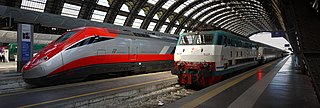
The Italian railway system is one of the most important parts of the infrastructure of Italy, with a total length of 24,227 km (15,054 mi) of which active lines are 16,723 km (10,391 mi). The network has recently grown with the construction of the new high-speed rail network. Italy is a member of the International Union of Railways (UIC). The UIC Country Code for Italy is 83.

Roma Termini is the main railway station of Rome, Italy. It is named after the district of the same name, which in turn took its name from ancient Baths of Diocletian, which lies across the street from the main entrance. It is Italy's busiest railway station and the fifth-busiest in Europe, with a traffic volume of approximately 150 million passengers per year, and with 850 trains in transit per day.
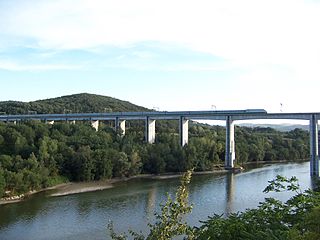
High-speed rail in Italy consists of two lines connecting most of the country's major cities. The first line connects Turin to Salerno via Milan, Bologna, Florence, Rome and Naples, the second runs from Turin to Venice via Milan and Verona, and is under construction in parts. Trains are operated with a top speed of 300 km/h (190 mph).

Venezia Santa Lucia is the central station of Venice in the north-east of Italy. It is a terminus and located at the northern edge of Venice's historic city . The station is one of Venice's two most important railway stations; the other one is Venezia Mestre, a mainline junction station on Venice's mainland district of Mestre. Both Santa-Lucia and Mestre stations are managed by Grandi Stazioni and they are connected to each other by Ponte della Libertà.

Nuovo Trasporto Viaggiatori S.p.A. is an Italian open-access train operating company operating in the field of high-speed rail transport under the brand name Italo, stylized as .italo.

The Milan–Bologna high-speed railway is a railway line that links the cities of Milan and Bologna, part of the Italian high-speed rail network. It runs parallel to the historical north–south railway between Milan and Bologna, which itself follows the ancient Roman Road, the Via Aemilia. The new railway follows the Autostrada A1 closely for much of its length. The new line allows faster traffic to run separated and increase the overall railway capacity between the two cities.

Napoli Centrale is the main railway station in the city of Naples and in southern Italy and the sixth largest station in Italy in terms of passenger flow with an annual ridership of 50 million. It is located next to Piazza Garibaldi to the east of the old city. It is the primary rail terminus and station for Naples, and serves Trenitalia national railways and EAV. This one has an underground section known as Stazione di Napoli Piazza Garibaldi, which is served by the metropolitan trains of the line 2, line 1 (Garibaldi), and 3, 12, 14, and 15 EAV Circumvesuviana lines which is accessible from 2 entrances inside the Centrale station, 1 outside in glass, and from the new Garibaldi Square.

Torino Porta Susa is a railway station in Turin, northern Italy; it is the second busiest mainline station in the city, after Torino Porta Nuova. It is located in Corso Inghilterra.

Torino Porta Nuova railway station is the main railway station of Turin, northern Italy. It is the third busiest station in Italy after Rome Termini and Milan Central, with about 192,000 journeys per day and 70 million travellers a year and a total of about 350 trains per day. Porta Nuova is a terminal station, with trains arriving perpendicularly to the facade. The station is located in Corso Vittorio Emanuele II, right in front of Piazza Carlo Felice.

Parma is a railway station serving the city of Parma, in the region of Emilia-Romagna, northern Italy. The station opened in 1859 and is located on the Milan–Bologna railway, Pontremolese railway, Brescia–Parma railway and Parma–Suzzara railway. The train services are operated by Trenitalia, Trenord and Ferrovie Emilia Romagna.
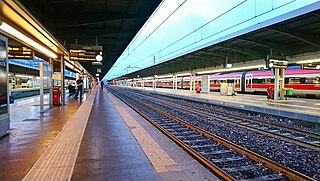
Venezia Mestre railway station is a junction station in the comune of Venice, Italy. It is located within the mainland frazione of Mestre, and is classified by its owner, Rete Ferroviaria Italiana, as a gold category station.

Padova railway station, or Padua railway station, sometimes referred to as Padova Centrale, is the main station serving the city and comune of Padua, in the Veneto region, northeastern Italy.
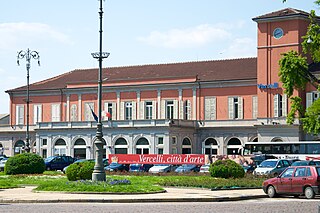
Vercelli railway station is the main station serving the city and comune of Vercelli, in the Piedmont region, northwestern Italy. Opened in 1856, it forms part of the Turin–Milan railway, and is also a junction station for two other lines, to Valenza and Pavia, respectively.

Brescia railway station is the main station of Brescia, in the region of Lombardy, northern Italy. The station, opened in 1854, lies on the Milan-Venice railway and is a terminus of three branch lines: Valcamonica Railway to Edolo, Bergamo–Brescia railway and Brescia–Piadena/Cremona railway which branches off towards southeast of the station.

Modena railway station is a railway station serving the city of Modena, in the region of Emilia-Romagna, northern Italy. The station opened in 1859 and is located on the Milan–Bologna railway, Verona–Modena railway and Modena–Sassuolo railway. The train services are operated by Trenitalia and Ferrovie Emilia Romagna.
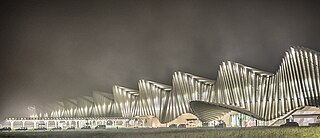
Reggio Emilia AV Mediopadana is a high speed railway station in Reggio Emilia, Italy. The station is located on the Milan–Bologna high-speed railway and Reggio Emilia-Guastalla railway. The train services are operated by Trenitalia, Nuovo Trasporto Viaggiatori and Ferrovie Emilia Romagna.

Frecciargento is a high-speed train of the Italian national train operator, Trenitalia, as one of its Le Frecce brands. The name, which means "Silver Arrow", was introduced in 2012; these trains were previously branded as Eurostar Italia. Frecciargento trains operate at speeds of up to 250 kilometres per hour (155 mph).


























